I guess the main thing that has happened is that we were forced to move to new rooms, since they wanted to refurbish the flat we were in downstairs. They've made the remaining three of us, Kris, Ed, and myself, move into Flat 5, which is right above Flat 4. They did this so that we could run phone cables out the window of our old rooms, straight up the side of the building and into our new rooms so we wouldn't have to pay to have our phones changed. They provided the cables, and have been acting as if we should be really grateful to them. I feel it was the least they could do, since one of the only reasons I stayed here for the summer was that I didn't want to deal with the hassle of moving. Moving off campus would have saved me money, and given me potentially better accommodation. Still, there is not much we could say about it, and we are now upstairs.
On the 22nd of June I went to Alan Pearce's 65th Birthday Party. It was a huge affair with over a hundred people in attendance. They catered the event and had everybody donate money for one of their charities instead of bringing gifts. Although I enjoyed it, it was a little awkward since I didn't know many people there. Alan introduced me to one of the girls, Rachel, that had been in his Junior Choir, and was now at University of Birmingham. She was heading off on a one year scholarship to one of the big schools in the East, and I was able to give her some information and advice on going to school in the US.
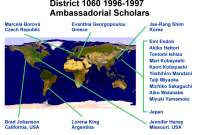 Warwick,
where both the Orientation and the Christmas Meal had been held.
This time we scholars got to provide the food, each of us bringing one
dish from our native countries. I had talked to Jennifer Haney, the
other American Scholar, before the meal, and we both didn't really know
what to bring, since it is difficult to come up with a unique American
Meal. In the end I made a Tuna Noodle Casserole, which I make for
myself all the time, and which is a fairly typical middle class American
dish. Jennifer wound up making a Taco Salad, which is sort of a Mexican
dish with an American spin to it. The Japanese scholars were the
ones that had the most difficult time, since there were ten of them, and
they had to try not to bring the same things. While they were all
very good, Yoshihiro's red-bean pudding really stood out (see him setting
it out at right), and I was
Warwick,
where both the Orientation and the Christmas Meal had been held.
This time we scholars got to provide the food, each of us bringing one
dish from our native countries. I had talked to Jennifer Haney, the
other American Scholar, before the meal, and we both didn't really know
what to bring, since it is difficult to come up with a unique American
Meal. In the end I made a Tuna Noodle Casserole, which I make for
myself all the time, and which is a fairly typical middle class American
dish. Jennifer wound up making a Taco Salad, which is sort of a Mexican
dish with an American spin to it. The Japanese scholars were the
ones that had the most difficult time, since there were ten of them, and
they had to try not to bring the same things. While they were all
very good, Yoshihiro's red-bean pudding really stood out (see him setting
it out at right), and I was 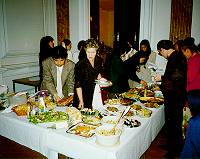 told
by the other Japanese scholars that it is quite difficult to prepare.
At the end of the evening the Scholars also presented gifts to the various
District Level Rotarians which had been of great help to us during the
year. At the going-away picnic we had for Lorena, we had decided
to get David Robinson, who has done all of the talk coordination this year,
a T-Shirt with a world map and the countries of origin of all of the scholars.
Since I have easier access to computers than most, I made the design (see
image at left) and went and had the T-Shirt made. It has an image
of the earth as it would look from space without any clouds, to show that
it is one world, and boundaries are somewhat arbitrary, and there are lines
from each represented country to the scholars from there. We also got David
a CD-ROM atlas so that he will be able to look up information on countries
of origin for scholars in future years. Finally Peter Isherwood,
the District Governor, and John Locke, the District Foundation Chairman,
were given cards and flowers. The evening was very enjoyable, but
also a little bitter sweet, as many of us will only be able to stay in
touch by mail and e-mail from now on.
told
by the other Japanese scholars that it is quite difficult to prepare.
At the end of the evening the Scholars also presented gifts to the various
District Level Rotarians which had been of great help to us during the
year. At the going-away picnic we had for Lorena, we had decided
to get David Robinson, who has done all of the talk coordination this year,
a T-Shirt with a world map and the countries of origin of all of the scholars.
Since I have easier access to computers than most, I made the design (see
image at left) and went and had the T-Shirt made. It has an image
of the earth as it would look from space without any clouds, to show that
it is one world, and boundaries are somewhat arbitrary, and there are lines
from each represented country to the scholars from there. We also got David
a CD-ROM atlas so that he will be able to look up information on countries
of origin for scholars in future years. Finally Peter Isherwood,
the District Governor, and John Locke, the District Foundation Chairman,
were given cards and flowers. The evening was very enjoyable, but
also a little bitter sweet, as many of us will only be able to stay in
touch by mail and e-mail from now on.
Last Monday I went into campus and had lunch with a lady who will probably be the new Assistant-Anglican Chaplain at the University, replacing Hillary Benson who is going to be a Chaplain at a school down in Oxford. There were several AngSoc Members that talked to her, but it was a little strange for me since I won't be here next year when she starts her tenure.
On Thursday I went to see Howard Stern's Private Parts with Kris. This was interesting since I was able to fill Kris in on who Howard Stern is, since he seems to be pretty much an American Phenomena.
I've also been working on organizing a couple of weeks of travel around Europe. It seems like to good an opportunity to miss, since I am already over on this side of the Atlantic (I won't get into the debate of whether the UK is part of Europe, since I have heard both people from the UK, and from Europe say that the UK is not really part of Europe). My problem right now is when and where to go to, and (hopefully) finding someone to go with me, since I don't like traveling by myself.
Finally, worth a mention is that yesterday was July 4th, Independence Day, which funnily enough isn't much celebrated over here in England! There was a contest at the local radio station to win a trip to New York for July 4th, but other than that there had been hardly a peep. Not that I expected to hear anything. The television here is having a special on the landing of the Mars Pathfinder Mission on Mars, but even they are not mentioning that the landing has been timed for July 4th.
On a related note, Hong Kong was returned by the UK to mainland China on July 1st. My British roommates weren't to happy about that, saying that it was a national shame to surrender territory to a communist state. They also were talking about how this had never happened in the history of the Empire. "Yeah, sure," they said, "maybe we surrendered some things, but we always came back to reclaim it, and the only parts of the empire that were lost were given independence by us." I didn't think much of it at the time, but today I brought up the fact that England was forced to surrender the US, and they never re-captured it. They said that it doesn't really count since the colonists were all Englishmen anyway, and, besides, they had a crazy King at the time and can hardly be blamed! Oh, well, it is all water under the bridge at this point anyway.
Other than that, the only interesting thing to report is that I went to London this past Tuesday. Jeff Hart, as I mentioned above, is on assignment in London, and he found out about a Cornell Alumni event in London last Tuesday night, so I went down there. It was in "Ye Olde Cheshire Cheese", an old Pub on Fleet Street in London. Unfortunately the event turned out to be everybody turning up after work for a drink at the Pub, and we weren't able to figure out who was an Alumni, and who was just relaxing for a drink. It also turned out that it wasn't a Cornell Alumni event, but open to all Young Alumni from East Coast/Ivy League schools. I spent the night with Jeff, and then headed back to Birmingham on Wednesday. One good thing that I did get done was to have my ticket for my trip back to the US in September finally confirmed at a travel agent in London.
|
|
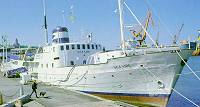 The
hostel is actually a ship, the M/S Seaside, which is now permanently
docked in Gothenburg Hostel (see left). By the time I had checked
into the Hostel, it was almost 9:30pm, which wasn't to late considering
Sweden is one hour ahead of the UK. I was feeling tired, though,
and didn't want to spend a lot of time finding a place to eat dinner, so
I went to a seafood restaurant called 'Kajskul 8' which was literally 50
yards from the gangplank of the hostel. I wasn't really in the mood
for seafood, and it was a bit on the expensive side, so I opted for a caesar
salad again (which turned out to be a chefs salad with caesar dressing,
but that is about the best I've been able to do in Europe). An older
Swedish couple joined me at the same table, and we talked a bit, although
their English wasn't too good, and my Swedish even worse (non-existent).
I did manage to tell them where I was from, and they told me about the
big football/soccer competition in Gothenburg this week. The man
also tried to ask me if I was here to visit my Swedish woman, to which
I responded no. He then told me that I needed to get a Swedish woman,
and I told him I would be visiting a Swedish woman when I went to Stockholm.
This still wasn't good enough for him, though, as he said I needed a Swedish
woman in Gothenburg! I told him that I would try, and his wife told
him that he was impossible, and we moved on to other topics.
The
hostel is actually a ship, the M/S Seaside, which is now permanently
docked in Gothenburg Hostel (see left). By the time I had checked
into the Hostel, it was almost 9:30pm, which wasn't to late considering
Sweden is one hour ahead of the UK. I was feeling tired, though,
and didn't want to spend a lot of time finding a place to eat dinner, so
I went to a seafood restaurant called 'Kajskul 8' which was literally 50
yards from the gangplank of the hostel. I wasn't really in the mood
for seafood, and it was a bit on the expensive side, so I opted for a caesar
salad again (which turned out to be a chefs salad with caesar dressing,
but that is about the best I've been able to do in Europe). An older
Swedish couple joined me at the same table, and we talked a bit, although
their English wasn't too good, and my Swedish even worse (non-existent).
I did manage to tell them where I was from, and they told me about the
big football/soccer competition in Gothenburg this week. The man
also tried to ask me if I was here to visit my Swedish woman, to which
I responded no. He then told me that I needed to get a Swedish woman,
and I told him I would be visiting a Swedish woman when I went to Stockholm.
This still wasn't good enough for him, though, as he said I needed a Swedish
woman in Gothenburg! I told him that I would try, and his wife told
him that he was impossible, and we moved on to other topics.
A couple other things happened since my last entry. This past Sunday I went up to the Pearce's and had a nice meal with them, and helped Anne to figure out a few things with their computer. They are playing host to two teenagers, a Dane and a Turk, who are attending a Rotary Camp in the UK, and Alan, Anne, myself and the two of them took a drive up through the Peak district, seeing among other things Arbor Low, an ancient stone circle similar to Stonehenge. On Monday, Kris and Brett also returned to the flat. Kris had been gone for a week getting his wisdom teeth removed, and Brett is up visiting while he finishes his dissertation. Brett also brought up his ruck sack, which is the same one I borrowed when I traveled with Rebecca at Christmas time, so once again I will have a pack to carry my stuff around in while I travel. In return Brett is staying in my room until I get back from this trip.
As for now, I will go to sleep, since it is 11:30, and I'd like to have as much time as possible to see Göteborg tomorrow.
It was a full couple of days in Gothenburg. I woke up yesterday
and went first of all to visit the boats in the Maritime Center (see right),
which is where my hostel was. It is billed as the largest boat museum
in the world and has eight permanently docked vessels, including a submarine
and a  destroyer.
It was interesting to look around the vessels, and the destroyer, although
"obsolete" still seemed pretty formidable to me. I sat down for a
minute with my Gothenburg Guide book, which I had picked up at the
hostel, to plan out the day, and saw that for SEK 125 (about $17) you could
get a 'Gothenburg Card', which provided free admission to many places and
tours in
destroyer.
It was interesting to look around the vessels, and the destroyer, although
"obsolete" still seemed pretty formidable to me. I sat down for a
minute with my Gothenburg Guide book, which I had picked up at the
hostel, to plan out the day, and saw that for SEK 125 (about $17) you could
get a 'Gothenburg Card', which provided free admission to many places and
tours in 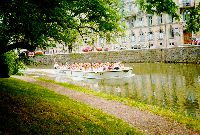 the
city. It seemed like a good idea and I decided to get it. I
also noticed then that admission to the Maritime Center was free, and that
I could have saved SEK 50 by waiting until I got the card. Oh, well,
you can't win them all.
the
city. It seemed like a good idea and I decided to get it. I
also noticed then that admission to the Maritime Center was free, and that
I could have saved SEK 50 by waiting until I got the card. Oh, well,
you can't win them all.
After grabbing lunch, and putting my pack in a locker, I purchased the card, and went down to Kungsportsplatsen, which is kind of the center of the city, and means something like "King's Gate Place". From there I took a Paddan Boat tour (see left) which went around the canals in the city, and then out and past some of the sights in the harbor. I learned that the city was founded by King Gustav Adolfus I (??) to protect the south of Sweden from Danish incursions. The best location for the city was on marsh land, so he hired Dutch engineers, who were used to draining land, to build the city. They designed it with a series of canals similar to Amsterdam. It was these canals that we traveled on during the tour.
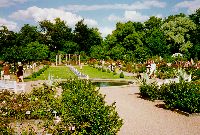 |
 |
By this time it was getting fairly late, so I had dinner and went back to the Hostel. It was a gorgeous day, so I sat up on the top deck of the boat and worked on reconstructing journal entries as the sun went down. It was absolutely magnificent-- the temperature was just perfect, and only a hint of a breeze. I was able to watch the boat traffic going back and forth in the harbor, and the city behind me painted golden with the waning light of the sun. I can't think of a more pleasant place to spend an evening typing.
This morning  I
packed up and moved out of the hostel, throwing my pack in a locker at
the train station before heading down to the city center again. I
had made a reservation on a bus & boat
I
packed up and moved out of the hostel, throwing my pack in a locker at
the train station before heading down to the city center again. I
had made a reservation on a bus & boat 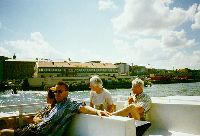 tour
of the city for the morning which was included in the Gothenburg Card.
Normally the tour was SEK 120, and considering that the card was only SEK
125, this trip alone almost made it worth while. It was a nice tour,
but it did cover some of the same things as the boat tour I took yesterday.
The bus took us west out toward the entrance of the harbor, and then we
took the boat back into the main part of Gothenburg (see right).
We also get to go to the North side of the harbor, which I had not yet
seen. That area was the location of the Volvo plant where they build
almost 100,000 cars per year, and employ 80,000 workers. We also
went up on top of a mountain overlooking Gothenburg where we were able
to take some pictures (see left and below).
tour
of the city for the morning which was included in the Gothenburg Card.
Normally the tour was SEK 120, and considering that the card was only SEK
125, this trip alone almost made it worth while. It was a nice tour,
but it did cover some of the same things as the boat tour I took yesterday.
The bus took us west out toward the entrance of the harbor, and then we
took the boat back into the main part of Gothenburg (see right).
We also get to go to the North side of the harbor, which I had not yet
seen. That area was the location of the Volvo plant where they build
almost 100,000 cars per year, and employ 80,000 workers. We also
went up on top of a mountain overlooking Gothenburg where we were able
to take some pictures (see left and below).
 |
Yesterday was quite a busy day. We woke up at 8am, and had breakfast. I had my first taste of traditional Swedish food by having filmjölk on my cereal. It is a special soured milk that is as thick as yogurt. It is not the type of thing that I will have on my cereal everyday, but I did manage to finish the bowl.
After breakfast, Bengt came back over, and we headed out for a day on
the Archipelago, the system of 24,000 islands surrounding 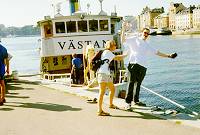 Stockholm.
We started by taking a ferry (see left) from the center of Stockholm out
to Vaxholm, a town out on one of the islands in the Archipelago.
On the way out we passed first through the more built-up part of Stockholm
and saw a pair of construction cranes painted as giraffes. They pointed
them out to me, and said that they were migratory giraffes which flew up
from Africa in the summer, stopping briefly in Germany on the way.
They told me that I was lucky to see them, as they would be flying back
to Africa for the winter in a month or so. The ferry made its way
out from the built-up parts, and soon we were traveling between the small
islands of the archipelago, each with a scattering of quaint cottages and
boat docks.
Stockholm.
We started by taking a ferry (see left) from the center of Stockholm out
to Vaxholm, a town out on one of the islands in the Archipelago.
On the way out we passed first through the more built-up part of Stockholm
and saw a pair of construction cranes painted as giraffes. They pointed
them out to me, and said that they were migratory giraffes which flew up
from Africa in the summer, stopping briefly in Germany on the way.
They told me that I was lucky to see them, as they would be flying back
to Africa for the winter in a month or so. The ferry made its way
out from the built-up parts, and soon we were traveling between the small
islands of the archipelago, each with a scattering of quaint cottages and
boat docks.
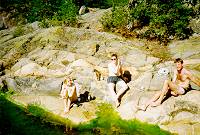 |
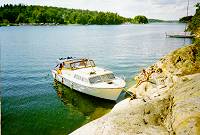 |
Cecilia's parents brought us back into Vaxholm, and then we caught another ferry back into central Stockholm. After stopping back at Cecilia's for a shower and change of clothes, the three of us went out to eat at Pizza Hut, since it is one of the more reasonable restaurants, and we didn't have time to cook (we were already late for the party). Unfortunately, Pizza Hut had meal deals for two people, but not for three, and we spent almost 20 minutes debating which combination of dishes would be the cheapest, and get us the right amount of food. Eventually we figured it out, and had a satisfying dinner.
After this, we headed off to the party, and after a few errors in navigation, finally made it there. Bengt and I were a little embarrassed about giving the Sea Troll to the hosts of the party, but didn't have anything to worry about, as the hosts thought it was pretty funny (I am still not sure how funny they will find it in a couple days when the seaweed starts to decay!). The party was an interesting experience, as not only did I not know anyone there (except Bengt and Cecilia), but most of the conversation was in Swedish (just about everybody spoke English, though). Everybody was pretty friendly, however, and several people made a point of coming up and talking to me in English for a while. I met one guy who's last name was Johnsson, but at first I thought he had said Johansson. He told me that his great-grandparents had immigrated to Wisconsin, which is also where my great-grandparents are from, so we decided that we could be relatives. Then, later, we figured out the names were actually different, but by that time enough beer had been drunk that it didn't seem to matter, and the running joke was that we were long-lost cousins. Another big topic of conversation was American movies and music, which is fairly popular in Sweden. Most seemed to agree that American humor was a little too broad for them, however. There also seemed to be a consensus among most that Americans tend to be very ignorant about the rest of the world, citing especially that some Americans don't know the difference between Sweden and Switzerland. This wasn't something I could easily refute, but I did comment that the US is such a big country, only borders with two others, that the concept of other nations is not as immediate a concern as it is of necessity in European countries. Everybody was good natured about the subject, however, and the entire evening went well.
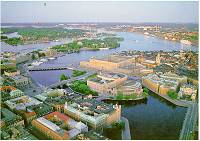 |
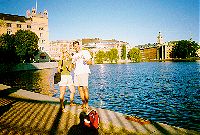 |
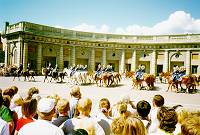 .
I enjoyed this ceremony much more than the one at Buckingham Palace in
London, for several reasons. One thing that was nice was that you
were actually allowed into the courtyard where the changing of the guard
took place, while in London you had to look through the bars. They
also played a lot more music, so it was a more interesting ceremony.
Finally, it was cool to see the band performing on horseback, especially
the drummers who rode hands free. The soldiers in the ceremony were
all in their teens, and serving on their compulsory 10 to 15 month military
service, so they weren't really as professional as those at Buckingham
Palace, but this, perhaps,
.
I enjoyed this ceremony much more than the one at Buckingham Palace in
London, for several reasons. One thing that was nice was that you
were actually allowed into the courtyard where the changing of the guard
took place, while in London you had to look through the bars. They
also played a lot more music, so it was a more interesting ceremony.
Finally, it was cool to see the band performing on horseback, especially
the drummers who rode hands free. The soldiers in the ceremony were
all in their teens, and serving on their compulsory 10 to 15 month military
service, so they weren't really as professional as those at Buckingham
Palace, but this, perhaps, 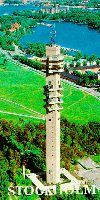 made
it seem even more impressive.
made
it seem even more impressive.
After the ceremony we went out to the Kaknästornet, or "Cookie
Tower", as Bengt dubbed it 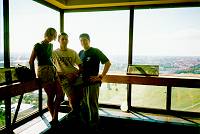 (Kaka
means cookie and tornet is tower in Swedish). When Cecilia first
heard him call it this, she nearly died laughing, since apparently that
is a rather liberal translation of the meaning, and not exactly what the
name conjures up in Swedish. In any case, we went to the tower which
is a little over 500 feet tall (see photo at left of us at the top, and
photo at right of the tower itself), and stands at the outskirts of Stockholm,
with a commanding view of the city. This view gave me a good idea
of where everything was located, and I could see many of the places I had
been, including Vaxholm out in the Archipelago.
(Kaka
means cookie and tornet is tower in Swedish). When Cecilia first
heard him call it this, she nearly died laughing, since apparently that
is a rather liberal translation of the meaning, and not exactly what the
name conjures up in Swedish. In any case, we went to the tower which
is a little over 500 feet tall (see photo at left of us at the top, and
photo at right of the tower itself), and stands at the outskirts of Stockholm,
with a commanding view of the city. This view gave me a good idea
of where everything was located, and I could see many of the places I had
been, including Vaxholm out in the Archipelago.
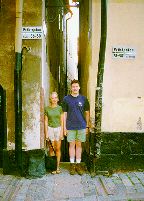 |
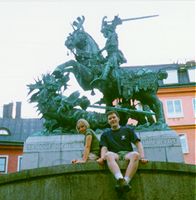 |
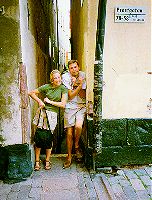 |
 |
 |
Finally we returned home for good, and Cecilia and Bengt cooked dinner for the three of us. We had a fairly traditional Swedish meal (according to them), of Swedish Meatballs and brown sauce, new potatoes, salad and lingon berry sauce. I'd had all of the items separately before, so there were no great surprises, but it was still an enjoyable dinner. Now Bengt has gone home, Cecilia is asleep as she has to work tomorrow, and I am about to do the same.
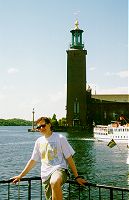 |
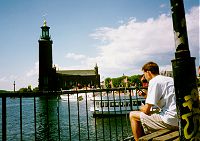 |
After lunch and some shopping, we went to the Medieval Museum. When building a parking lot back in the early eighties, construction workers uncovered a cache of artifacts from Medieval times in Stockholm. The plans for a parking lot were scrapped, and instead the site was excavated, then turned into a museum about Medieval times in Stockholm. It was very interesting to see some of the things on display, and they had reconstructed buildings of the time, and had many things describing what it was like to live in the Middle Ages in Stockholm (in short: not very nice!). They also found many skeletons in the excavation. There was one display there which described how they were able to examine the skeletons and determine their sexes, ages, diseases and mishaps the people had suffered, and often the cause of death.
When the Medieval Museum closed, we tried to make it to the Royal Armoury,
which we unfortunately found closed for the day. Instead 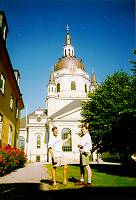 we
went past Slussen and up the hill to the Katarina Church (see right), and
important landmark that looks over Stockholm. Unfortunately, in 1990
a fire destroyed almost the entire church, so all that we were able to
see was what had been rebuilt. They had some diagrams and photos
of the interior of the building, and it looked like it must have been magnificent.
It was a bit disappointing that I was not able to see it as it was before
the fire.
we
went past Slussen and up the hill to the Katarina Church (see right), and
important landmark that looks over Stockholm. Unfortunately, in 1990
a fire destroyed almost the entire church, so all that we were able to
see was what had been rebuilt. They had some diagrams and photos
of the interior of the building, and it looked like it must have been magnificent.
It was a bit disappointing that I was not able to see it as it was before
the fire.
From the church we hurried down to the water, and took a ferry across the water to meet Cecilia, and her boyfriend Jonas, who had just gotten off work. The four of us then went to see the Vasa Museum, which displays a 17th Century battleship, The Vasa. The ship was supposed to have been one of the biggest in the fleet, but the design was top heavy, and the ship sank 45 minutes into its maiden voyage. The ship could not be recovered at the time, and over three hundred years later in 1956, the location in Stockholm harbor was discovered, and salvage operations began. Since the Baltic is a brackish sea, the ship worms that normally destroy wooden ships did not damage it, and they were able to raise the ship almost whole from the bottom of the sea. Over the next 30 years, the ship was preserved in polyethylene glycol, and gradually rebuilt, until now she is on display in the museum. It was quite impressive to see the result of so much effort. I imagine more time and money was spent on rebuilding The Vasa than ever went into her original construction.
Finally, after a long day, we all went back to Cecilia's for dinner, and this time I got to cook. I made chicken parmesan, which is a dish I often make for myself, and thus was able to prepare without a recipe.
This morning's task was to get my laundry done, as I have reached the halfway point of the trip and run out of clean clothes. The launderette in Cecilia's building requires reservations, and was completely booked, so I could not do my clothes there. Also, since everyone here apparently has a launderette available to them, there are no laundromats in the city where you can go and do laundry, and it was to late to drop everything at a dry cleaner. In the end I found a Hostel with facilities, and I was able to convince them to let me use it even though I wasn't staying with them. By the time I finished laundry and met Bengt, however, it was 2pm. Still, we made the best of the afternoon, and managed to see a few museums.
First we went to the Royal Armoury (actually we met there), which had been closed the day before. The Armoury is located in the basement of the Royal Palace. As the name implies, here they had armor and weapons from the various monarchs of Sweden through the ages. In addition they also had royal carriages, clothing, books, and items of silver that had been exchanged with other kingdoms as gifts during various diplomatic negotiations. I found it interesting that they had the clothing that some of the kings died in. Most were from Kings who had died on the field of battle, but one had been assassinated during a royal ball. They also had one of the King's horses stuffed and on display!
The second museum we went to was the Historik Museet, which translates
into "The National Museum of Antiquities," even  though
one might thing otherwise (including Bengt who obviously speaks Swedish!).
In any case, the museum houses objects related to the history of Sweden
through the ages. The most impressive exhibition was called the Gold
Room, and contains over 50 kg of gold artifacts, and more than 100 kg of
silver artifacts. It was all well documented in Swedish and English,
and explained how the use of gold had changed over the ages, starting several
hundred years Before Christ. It was also remarkable to see how intricate
some of the gold work was, especially on some of the collars on display
(see picture at left). We also managed to see some Viking artifacts
before the museum closed.
though
one might thing otherwise (including Bengt who obviously speaks Swedish!).
In any case, the museum houses objects related to the history of Sweden
through the ages. The most impressive exhibition was called the Gold
Room, and contains over 50 kg of gold artifacts, and more than 100 kg of
silver artifacts. It was all well documented in Swedish and English,
and explained how the use of gold had changed over the ages, starting several
hundred years Before Christ. It was also remarkable to see how intricate
some of the gold work was, especially on some of the collars on display
(see picture at left). We also managed to see some Viking artifacts
before the museum closed.
After this Bengt headed home, as he is taking care of some cats, and he needed to go and give them some TLC, as they had been neglected a bit while I had been here. I went to Central Station where I met Jonas and Cecilia, and we went to dinner in Gamla Stan at an Italian restaurant, and then got an ice cream. We wandered around the city some, and one funny incident happened when I went into McDonald's to get a drink. I noticed that one of the drinks was called "mellanstor", and I thought that I would try a local Swedish drink for a change. I told the clerk that I wanted to order a large "mellanstor", and she seemed a bit confused, and asked what flavor I wanted. I said "mellanstor," but she still seemed confused. Finally the guy behind me in line said, "Mellanstor is not a drink, it is a size." Apparently, "mellanstor" means medium in in Swedish, so I had been asking for a large medium-- No wonder the clerk was confused. I changed to Sprite instead and all was well.
I see my train is at the platform now, even though it doesn't leave
for some time yet, so I will see if I can get on board. It is only
a 7 1/2 hour trip to Oslo, so if I can get on board early maybe I can get
a little bit more sleep.
Feeling refreshed, I was ready to tackle what to do for the day.
I bought an Oslo Card from somebody just leaving for 100 Norwegian Crown
(about $15) which allowed unlimited travel on public transport, and free
admission to just about every museum in Oslo. It also included a
sightseeing boat trip, and the first thing I tried to do was go on that.
There was twenty minutes until the next trip, and I didn't want to wait,
so instead I hopped on the subway to head up to the TV tower, which I assumed
I would be able to go out and see before the next boat an hour and twenty
minutes later.
 |
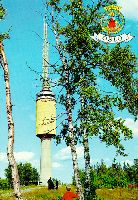 |
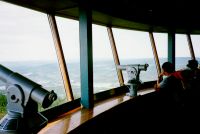 View of countryside |
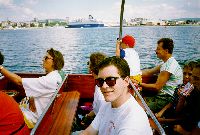 a
hike in the Norwegian wilderness as part of the deal!
a
hike in the Norwegian wilderness as part of the deal!
Having arrived back with 20 minutes before the next tour, I ducked into the National Gallery to look at The Scream by Munch, which is quite a famous painting by the Norwegian painter, and one I had particularly liked in my Art History class from High School. I also glanced at a few other works, before running out the door and down to the boat docks, arriving just before they pulled away for the tour.
The tour lasted one hour (see photo at right), running around the Oslofjord area, although there are not the high cliff walls normally associated with fjords. The tour wasn't the greatest, but it did point out the main features of the city, and allowed me to orient myself a little bit better.
I ducked into a McDonald's for lunch ($7 for a Big Mac and fries, and still one of the cheapest places in town-- it is expensive here!), and then headed over to Akershus, a fortress/castle which is one of the big features of Oslo. There was a guided tour of the castle at 3 pm, and I had about 13 minutes to spare, so I went through the Norwegian Resistance Museum which is on the castle grounds. The museum documents the invasion and occupation of Norway by the Nazis in World War II, and the efforts of the resistance movement in Norway. I missed a lot of the detail, though, since I had to run through half of the exhibits to make it to the Castle tour in time.
 |
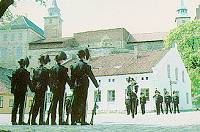 |
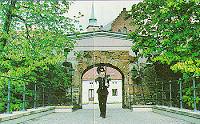 |
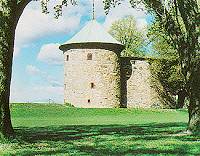 |
 |
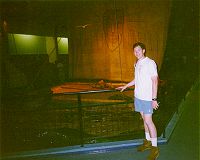 |
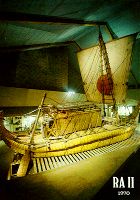 |
After seeing the Kon-Tiki museum, I hiked across Bygdoy to the Viking
Ship Museum. There they had three authentic Viking  ships
on display, ranging in size from 20 to 22 m (see one at left). Each
of the ships had been buried with a prestigious Viking leader, along with
other possessions to take with them into the afterlife. The skill
and precision of the wood work in the hulls was amazing considering that
the crafts were constructed in 800-900 AD.
ships
on display, ranging in size from 20 to 22 m (see one at left). Each
of the ships had been buried with a prestigious Viking leader, along with
other possessions to take with them into the afterlife. The skill
and precision of the wood work in the hulls was amazing considering that
the crafts were constructed in 800-900 AD.
After this I tried to get to the Viking Folk Museum, which has reconstructions of many different Norwegian buildings from different eras and locations in Norway. I got there just as it closed, and there wasn't much to see without going in, so I headed over to see the Polar Ship Fram, used by Amundsen to be the first to the South Pole. I just missed this too, and it was closed when I arrived. Instead I was able to look around the Norwegian Ship Museum, which demonstrated various styles of boat construction in Norway through the ages.
Finally, I took the ferry back to central Oslo, and walked up for a brief look at the Royal Palace, then went and ate dinner. Now I am back at the station, and they should be calling my train to Copenhagen at any minute.
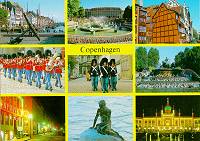 |
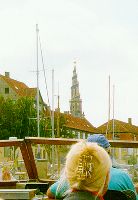 |
 Royal
Palace, as well as the old palace. They also pointed out the Crown
of Scandinavia, the ferry which travels back and forth to Oslo. This
was interesting for me, since the guide in Oslo yesterday pointed out the
very same boat!
Royal
Palace, as well as the old palace. They also pointed out the Crown
of Scandinavia, the ferry which travels back and forth to Oslo. This
was interesting for me, since the guide in Oslo yesterday pointed out the
very same boat!
After the tour I learned an important lesson on the way to lunch about crossing the street in Denmark-- just because you see a green walk symbol doesn't mean that you should go all the way across the road. It turns out that there are independent cross walk signs for the two halves of the road, and I almost was run over since I saw the sign for the other half of the road was lit, but there was on coming traffic on the side nearest to me. I won't make that mistake again!
In the InterRail center I had seen a sign for an "all you can eat" buffet offered by one of the restaurants in the city for just 29 Danish Crowns (about $4). This was an amazing price, especially after the prices of the past couple of days, so I went and ate there. They had salad, vegetables, pasta, pizza and garlic bread, none of an incredible quality, but then again the price was right.
After wandering around for a while, I headed over to Christiania Free
State. In 1970, a bunch of what would be called hippies in the US
decided to claim a section of Denmark for their own. They wanted
to live there with no laws at all, and so Christiania was born. It
seems the Danish government tried some sanctions against them, but in the
end gave up, so this small area of Copenhagen is beholden to no one, and
the occupants live in a more primitive fashion there, not using cars and
using old fashioned techniques for farming and building. It all sounds
pretty nice, but I suspect a big part of it is that most who live there
want to be able to smoke and grow pot. As I walked through the place
there were vendors everywhere selling marijuana in all of its incarnations.
Other than that all I noticed were some fairly decrepit buildings, 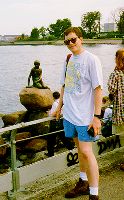 fences,
and roads in a state of general decay. Not the way I'd want to live,
but I guess it must be nice not paying taxes!
fences,
and roads in a state of general decay. Not the way I'd want to live,
but I guess it must be nice not paying taxes!
Finally I took a long walk from Christiania all the way up to Kastellet,
a military base where the Gefion Fountain, and the 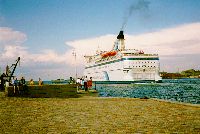 Little
Mermaid statue are both located. Mainly I did this to look at the
Little Mermaid from the land side (see photo at left), since when I'd seen
her on the boat trip earlier, her back had been to me. Along the
way I saw a ferry that was almost the same as the one I had taken from
Harwich to Gothenburg that was departing Copenhagen (see right).
Little
Mermaid statue are both located. Mainly I did this to look at the
Little Mermaid from the land side (see photo at left), since when I'd seen
her on the boat trip earlier, her back had been to me. Along the
way I saw a ferry that was almost the same as the one I had taken from
Harwich to Gothenburg that was departing Copenhagen (see right).
And that was it for today. My train left at 7:05 pm, so I had to get back to the station, bought a "danish" for breakfast (I couldn't say I went to Denmark and never got a "danish" now, could I?), and a sandwich for breakfast, and made it to my train with five minutes to spare. Now I share the evening with my compartment mates-- an Italian family and a Norwegian girl who is heading down to Venice on an InterRail pass to visit some friends. I arrive at 9:40am tomorrow in Munich, so after two nights of only seven or so hours of sleep, hopefully I will get a good nights sleep tonight.
The train trip to Germany actually was kind of interesting, so I will
talk a bit more about it. It turns out that to get over to Germany
from Denmark, they actually put the train onto a ferry! I had heard
of this, of course, but it was interesting to actually see what they do
(apparently while I was asleep on Wednesday night, they did the same with
the train from Oslo to Copenhagen). They broke the train into five
car segments, and put each onto the ferry, which has tracks on the deck,
side by side. They also had cars and buses parked among the train
cars, which was a strange sight to see. For the one hour crossing
to Germany we were able to get off the train and go onto the ferry which
had restaurants and shops. I spent most of the time chatting with
the girl from Norway, who, it turns out was a Girl Scout, and shares many
of my interests in outdoor activities. After the crossing everyone
went to sleep, and I woke in Munich.
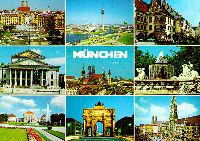 |
I stared out the touring by taking a trip out to Dachau, site of a former Nazi concentration camp (although it was never used as an extermination camp). During the tour I took, the conditions at the camp were described by the guide. Surprisingly, though appalling, the conditions and treatment of people there seemed downright civilized compared to the descriptions I have heard of how prisoners in medieval castles were treated. In the case of medieval castles, though, only a few people were subjected to the appalling treatment, while at Dachau I saw evidence of a systematic design, which was successfully used, to subject thousands, and even millions, of people to inhuman treatment. During the tour it also poured down rain, the first time during this trip, so I got to take the shower I had missed at the station, at the expense of being damp for a few hours afterward.
On returning from Dachau, I jumped onto a train to Fuessen with less
than a minute to spare. Fuessen is a small city at the foot of the
German Alps, from which one can visit Neuschwanstein, one of the castles
built by Ludwig II 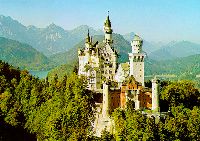 of
Bavaria, or "Mad King Ludwig" (see photo at right). The rain from
earlier tailed off during the two hour train ride up to Fuessen, and there
was just some wisps of missed blowing away from the castle when I
of
Bavaria, or "Mad King Ludwig" (see photo at right). The rain from
earlier tailed off during the two hour train ride up to Fuessen, and there
was just some wisps of missed blowing away from the castle when I 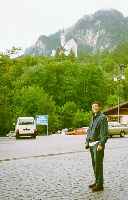 finally
arrived. I got there at 5:30pm, which was the castle closing time,
so I didn't get to go inside. I was able to hike up to the castle
and look around the outside, though. I am not sure which was more
impressive, the quaint medieval architecture (even though it was built
in the late 1800s), or the dramatic soaring mountains that surrounded the
hill the castle was on (see photo at left). Either way, it was worth
the 4 hours round trip to Fuessen and back (the view from the train on
the ride there and back was also quite nice).
finally
arrived. I got there at 5:30pm, which was the castle closing time,
so I didn't get to go inside. I was able to hike up to the castle
and look around the outside, though. I am not sure which was more
impressive, the quaint medieval architecture (even though it was built
in the late 1800s), or the dramatic soaring mountains that surrounded the
hill the castle was on (see photo at left). Either way, it was worth
the 4 hours round trip to Fuessen and back (the view from the train on
the ride there and back was also quite nice).
Finally, I had about an hour and a half once I got back from Fuessen, so I took a walk around the city of Munich. It was dark, but most of the landmarks were lit up. While walking around a lady came up to me and started to talk to me in German-- she thought I was from Munich (so far, I have been mistaken for a native in each place I've visited, so I must not look like a tourist)! She was looking for the Hoffbrauhaus, a famous beer hall, so I was able to show her on my tourist map. I later wandered past it, but didn't go inside.
The night train from Munich to Amsterdam was a bit of an adventure. I was the only one of the six in my compartment that spoke English. There were two women traveling together, a young German couple, and a very drunk older German who was making a joke about everything. The rest of the train was also full of drunk German's, so I can only guess everybody was getting in the spirit for a weekend away in Holland. Nobody seemed to want go to bed, and finally at 1 AM I used my German language skills to say "schlaffen", which got the point across that it might be good to go to sleep. Since the train arrived at 9:40 am the next morning in Amsterdam, I figured I could still get 8 hours of sleep, but then everybody woke up at 7 am, and wanted to put the bed down so we could sit in the compartment. So, despite an 11 hour train trip, I still was tired on arriving in Amsterdam. We did get breakfast on the train, though, so this somewhat made up for the lack of sleep.
On arriving in Amsterdam, I hiked out to the Eben Haezer Christian Hostel and checked-in, receiving a copy of the Gospel of John as part of the check in package. I was feeling pretty disgusting at this point, since I hadn't had a shower since Copenhagen two days earlier, but the showers in the Hostel were closed since it was during their cleaning hours. Fortunately I convinced them (or maybe my smell did), and they let me go up and take a shower anyway. Right before I went up, Jeff Hart walked in, having taken a walk around the local area. He had flown in from London earlier that morning.
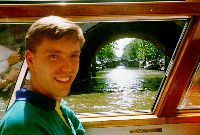 |
After eating lunch we decided that, instead of staying in Amsterdam,
we would head out of town to try and find something a little less urban.
We chose to take the train to Delft (see left), which seemed to fit the
bill. 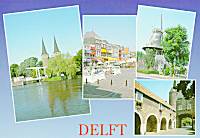 Jeff
also wanted to get some Delftware for his Mother, and this was another
good reason to go there. We also thought we might see The Hague,
since the train to Delft stopped there. Delft was a nice little town
to walk around, and we got to see a famous Dutch Windmill while we were
there. We didn't go to the big Delftware factory, but we did find
a small shop. It was looking like rain on the way back, so we decided
to skip The Hague, and headed straight back to Amsterdam.
Jeff
also wanted to get some Delftware for his Mother, and this was another
good reason to go there. We also thought we might see The Hague,
since the train to Delft stopped there. Delft was a nice little town
to walk around, and we got to see a famous Dutch Windmill while we were
there. We didn't go to the big Delftware factory, but we did find
a small shop. It was looking like rain on the way back, so we decided
to skip The Hague, and headed straight back to Amsterdam.
When we got back, we decided to try and find the Hard Rock Cafe, Amsterdam, since it is quite famous, and we figured it would be a decent place to eat dinner. The first tourist office we asked didn't know where it was, but the lady at the second one we went to told us how to get there. Upon arriving we were disappointed to find that it was only a bar, and didn't serve food. This was a bit strange, since one of Jeff's friends had recommended something on the menu to him. Instead we went to Planet Hollywood, which was a few blocks away, and I had one of the few "real" Caesar Salads I've had since coming to Europe (most places over here seem to think that putting Caesar dressing on any salad makes it a "Caesar" salad).
On our way back to the Hostel we walked through the famous, or infamous, Red Light District, since we figured we ought to at least see what it was like. Frankly it wasn't nearly as shocking as I had expected it to be (although maybe you have to go into some of the buildings to see the shocking stuff). There were many sex shops and XXX theaters around, but most big cities tend to have areas like that. Of course, it was a little different to see the products and sample photos on display where any passerby could see (even children, and there were some families wandering through), but still this wasn't so unusual. The legalized prostitution is what gets the most press, I guess, and the red lights that they turn on above their doors when they are working is what gives the district its name. Even this wasn't so shocking though, since all you saw were women wearing underwear standing in booths behind glass doors, not much different than you see some models wearing on TV. The difference, I guess, was the realization of what they were doing, and it still seems a little strange to me.
We called it an early evening, and got up for a pancake breakfast, included with the Hostel fee, on Sunday morning. The first thing we went to see was the Anne Frank House, about two blocks from our Hostel. This was the House where Anne Frank and her family hid from the Nazis in World War II, and where she wrote her famous Diary. The family was later discovered, and taken away to concentration camps, where all except Anne's father, Otto Frank, died. Although many school children read the Anne Frank Diary as part of their classes, I had never read the Diary, so knew little about the story. Touring the house, and learning about what this 13 year old girl had to go through really made the story real. The marks were on the wall where their father had measured their heights, and the photos that Anne had put up on the wall in her room were still there. Its shocking to believe that a government could arise that would seek to eliminate and punish people for a label attached to them, like "Jew", yet in this house there was the evidence of a normal family, which was destroyed by just such a government.
We spent some time wandering around the city after that, and went a saw a movie, which was fortunately in English with Dutch sub-titles. Jeff's flight left at 7 PM, so we went down to the station around five to give him time to take the train to the airport. While there I figured out what trains to take back on Monday. After this I went back to the Hostel where they served a free dinner to everybody (not normally included in the Hostel fee). We also heard a testimony from a prostitute/drug addict that used to work in the Red Light District until she had become a Christian. She has since gotten off of drugs, and now works in the Hostel as a chef. It was a very moving story. After this I took one more walk around to see the narrow canal houses, and tree lined canals of Amsterdam one last time.
Yesterday was a long day on the trains, and was honestly pretty boring.
At 7:30 AM I took the train from Amsterdam to Antwerp,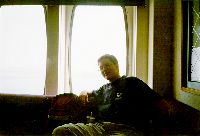 then from Antwerp to Lille, and then from Lille to Calais, and finally
a ferry (with a McDonald's on board!) across to Dover. There I saw
the only exciting thing of the day-- the cliffs of Dover are really white!
I always heard the saying "the white cliffs of Dover", but didn't really
think much of it until I saw them (see arrival photo at left with cliffs
barely visible in background). It is quite striking. From Dover
I took the train to London, where I stopped for dinner. Then finally
the train back to Birmingham, arriving home at 11 PM-- quite a long day!
then from Antwerp to Lille, and then from Lille to Calais, and finally
a ferry (with a McDonald's on board!) across to Dover. There I saw
the only exciting thing of the day-- the cliffs of Dover are really white!
I always heard the saying "the white cliffs of Dover", but didn't really
think much of it until I saw them (see arrival photo at left with cliffs
barely visible in background). It is quite striking. From Dover
I took the train to London, where I stopped for dinner. Then finally
the train back to Birmingham, arriving home at 11 PM-- quite a long day!
Today I have spent getting back on track here. I've unpacked, done laundry, and gone and done my shopping for the next couple of weeks. Hopefully starting tomorrow I can crack down and get to work in earnest on my Master's Thesis which is due in September. Since I plan to dedicate myself to that, the journal entries may be few and far between, but I'll try and take some time to jot down anything interesting that happens.